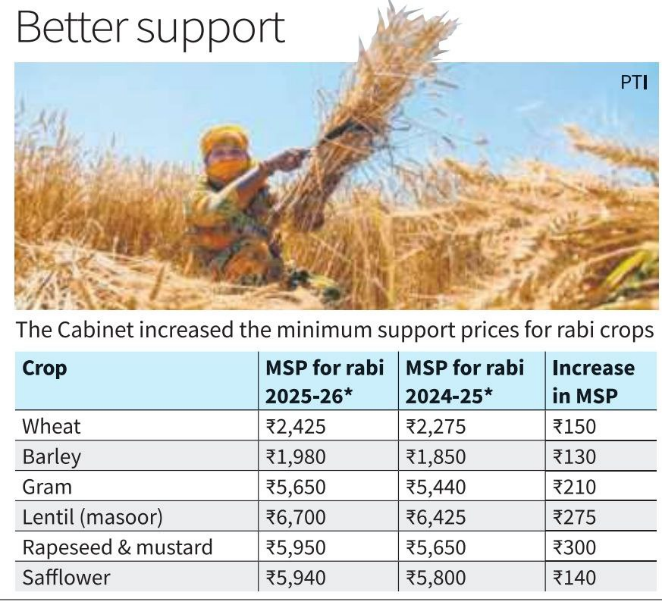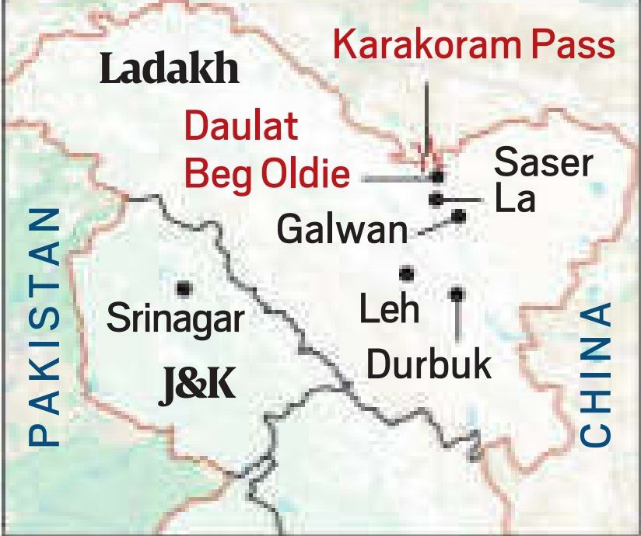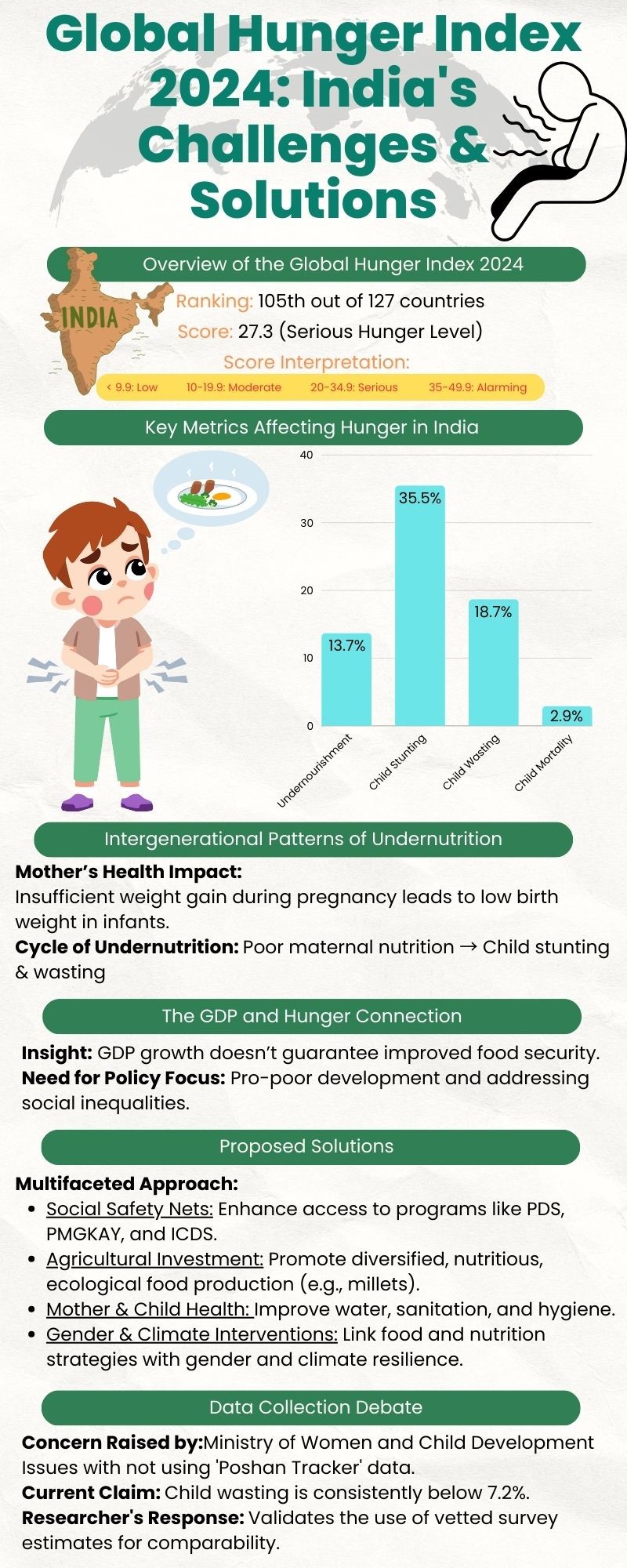1. MSP Hike for Rabi Crops (2025-26)
- Government Announcement: Centre increased the Minimum Support Price (MSP) for six Rabi crops for the 2025-26 marketing season, effective from October 16, 2024.
- Key Highlights:
- Objective: Ensure fair returns to farmers, especially focusing on crops of high priority for the government.
- Additional Context: The MSP hike is announced ahead of assembly elections in states like Maharashtra, Jharkhand, and Telangana, with no direct link between MSP hikes and elections according to government sources.
Economic Implications
- Current Rabi Season: Wheat production estimate for the 2024-25 season is 92 million tonnes, with Uttar Pradesh being the top wheat-producing state. Other leading states include Madhya Pradesh, Punjab, Haryana, Rajasthan, Bihar, Gujarat, Maharashtra.
- Procurement Target: For 2024-25, the government procured 6 million tonnes of wheat, benefiting 22 lakh farmers. The MSP hike aims to support this procurement drive.
Dearness Allowance (DA) Hike
- Government Decision: Centre increased Dearness Allowance (DA) for central government employees and Dearness Relief (DR) for pensioners by 3 percentage points effective from July 1, 2024.
- DA Rate Increase: From 45% to 48% of the basic salary/pension.
- This increase will benefit 1 crore employees and pensioners.
Infrastructure Development: Ganga Rail-Road Bridge (Varanasi)
- Project Overview:
- Approval of a ₹2,624-crore double-decker rail-road bridge over the Ganga in Varanasi.
- It will ease rail traffic on the Varanasi-Deen Dayal Upadhyaya (DDU) Junction route.
- Expected Completion: 4 years.
- Length: 1 km, India’s largest double-decker bridge.
- Features: Road and rail lines on separate decks.
2. Strategic Link to Northern Outpost in Ladakh
- National Board for Wildlife (NBWL) Approval:
- The Standing Committee of NBWL has cleared five key road stretches in Ladakh, four of which pass through the Karakoram Wildlife Sanctuary.
- These roads are critical for border infrastructure, particularly near the Line of Actual Control (LAC) with China.
- Key Roads Cleared:
- Chushul-Lukung to Thakung Post Road: Part of the India-China Border Roads (ICBR)-III Project, passing through the Changthang Cold Desert Sanctuary.
- Durbuk-Shyok-Daulat Beg Oldie (DS-DBO) to Saser-Brangsa-Gapshan Link Road: Crucial 75 km link road at an altitude of 17,000 feet.
- DS-DBO to Track Junction Road.
- DBO to Karakoram Pass Road: DBO is the country’s northernmost military outpost, housing India’s highest airstrip.
- Leh to Chalunka Road Upgradation.
- Strategic Importance:
- These road stretches will improve connectivity to Daulat Beg Oldie (DBO), a critical military base located near the Karakoram Pass.
- Total of 35 km of road approved, which includes upgrades in strategic border infrastructure.
- Military and Defence Implications:
- Strengthens India’s position in the high-altitude areas along the LAC.
Provides a logistical boost to the Ministry of Defence, allowing rapid military mobilization near the Ladakh region, crucial given ongoing tensions with China.
3. Climate Change Impact on Poor Farmers in India: FAO Report
- Key Findings:
- Income Loss: Poor households globally lose 5% of their total income annually due to heat stress and 4% from floods, compared to relatively better-off households.
- Negative Impact on Farmers: The Food and Agriculture Organization (FAO) report highlighted that poorer farming households in India are disproportionately affected by climate change.
- Challenges for Poor Farmers:
- Households exposed to significant climate stressors (droughts, floods, etc.) suffer more due to limited resources to sustain agricultural production.
- Structural inequalities aggravate the vulnerability of poor farmers to climate shocks.
- Recommendations by FAO:
- Workforce Diversification: Encouraging off-farm employment to reduce reliance on agriculture.
- Gendered Barriers: Address barriers that limit women’s participation in non-farm employment.
- Anticipatory Social Protection: Expanding social security nets and scaling up protection programs to help vulnerable groups in the face of extreme weather events.
- Livelihood Support: Effective livelihood support programs to be implemented ahead of extreme weather events to protect vulnerable communities.
- Government Response (India):
- NITI Aayog’s View: Ramesh Chand from NITI Aayog responded that India is actively addressing the climate change issue through programs like National Innovations on Climate Resilient Agriculture (NICRA).
- Proactive Measures:
- NICRA aims to make crops climate-resilient.
- Contingency plans for agriculture districts are in place to tackle extreme weather.
Employment guarantee schemes are used as social safety nets for those impacted by climate stressors.
4. Regulation of Antibiotics in India
Context:
- The Drugs Technical Advisory Board (DTAB) has recommended bringing all antibiotics under the category of “new drugs” as per the New Drugs and Clinical Trial (NDCT) Rules, 2019.
- This move is aimed at addressing the rising issue of antimicrobial resistance (AMR), a global public health threat.
Key Points:
- Antimicrobial Resistance (AMR):
- AMR is caused by the indiscriminate use of antibiotics, antifungals, and other antimicrobials.
- It leads to drug-resistant infections which are becoming harder to treat.
- Common resistant infections include:
- Urinary tract infections
- Bloodstream infections
- Pneumonia
- Typhoid
- DTAB Recommendations:
- Include all antibiotics in the definition of “new drug” under the NDCT Rules, 2019.
- Make prescriptions mandatory for the sale of antibiotics to regulate usage.
- Manufacture, marketing, and sale of antibiotics to be documented and regulated by the central government.
- Regulatory Implications:
- State drug administrations will oversee antibiotic sales, ensuring antibiotics can only be purchased with a prescription.
- Manufacturing and marketing clearance will need approval from the Union Government, centralizing the process.
- Proposed changes to labeling requirements under the Drugs Rules, 1945:
- Addition of a blue strip or box for antimicrobial products to make them easily identifiable.
- Significance of the Move:
- Addresses the growing concern of antimicrobial resistance in India and globally.
- Aims to curb the misuse of antibiotics and other antimicrobials, reducing the risk of further resistance.
- Aligns with global efforts to prioritize the containment of AMR at multiple health platforms.
Challenges & Solutions:
- Challenges:
- Widespread misuse of antibiotics in both the human and animal health sectors.
- Lack of awareness among patients about the dangers of antimicrobial resistance.
- Over-the-counter sales of antibiotics without proper regulation.
- Solutions:
- Strict enforcement of the new regulations.
- Public awareness campaigns to educate about AMR and the need for prescriptions.
Involving pharmaceutical companies and healthcare providers to ensure compliance with new rules.
5. 2024 Global Hunger Index (GHI)
2024 Global Hunger Index (GHI), which reflects the widespread issue of undernourishment in the country. The GHI report reveals that around 14% of India’s population—approximately 200 million people—are undernourished. India’s ranking of 105 on the index, with a score of 27.3, categorizes the hunger situation as “serious.”
Key Points:
- India’s Global Hunger Index Rank:
- Rank 105 out of 127 nations.
- Score of 3, considered a serious hunger situation.
- India’s undernourished population is about 200 million, equivalent to the population of Brazil.
- Significance of the GHI:
- The Global Hunger Index measures comprehensive data on undernourishment, child mortality, and child malnutrition (wasting and stunting rates).
- The data comes from the Sample Registration System (SRS) and reports from the Ministry of Women and Child Development and NITI Aayog.
- Contradiction with Economic Growth:
- Despite being the world’s fastest-growing economy with a growth rate of 8% in FY24 and an estimated GDP of $4 trillion, India’s per capita income remains low.
- Per capita income in FY24 is $2,485, less than a fourth of the global average of $13,920 (FY22), reflecting significant income inequality.
- Food Inflation and Production:
- Food inflation more than doubled from 8% to 7.5% between FY22 and FY24, severely affecting the poor.
- India recorded one of its highest food production levels in 2023-24, at 332 million tonnes, mainly due to bumper crops in rice and wheat.
- Despite high production, extreme weather conditions such as floods and droughts affected the production of pulses and vegetables.
- Health and Child Welfare Concerns:
- India’s infant mortality rate in 2022 was 26 per 1,000 live births, slightly better than the global average of 28.
- High stunting and wasting rates:
- Stunting (low height for age): 5%
- Wasting (low weight for height): 7%
- These figures indicate systemic failures in health, nutrition, and food security systems.
- Failure to Address Food Security:
- The article suggests a failure in India’s health care, food security, and welfare systems to ensure basic nutrition and address malnutrition.
Rising food inflation, unequal distribution of income, and extreme weather events are casting long-term risks on food security in India.





